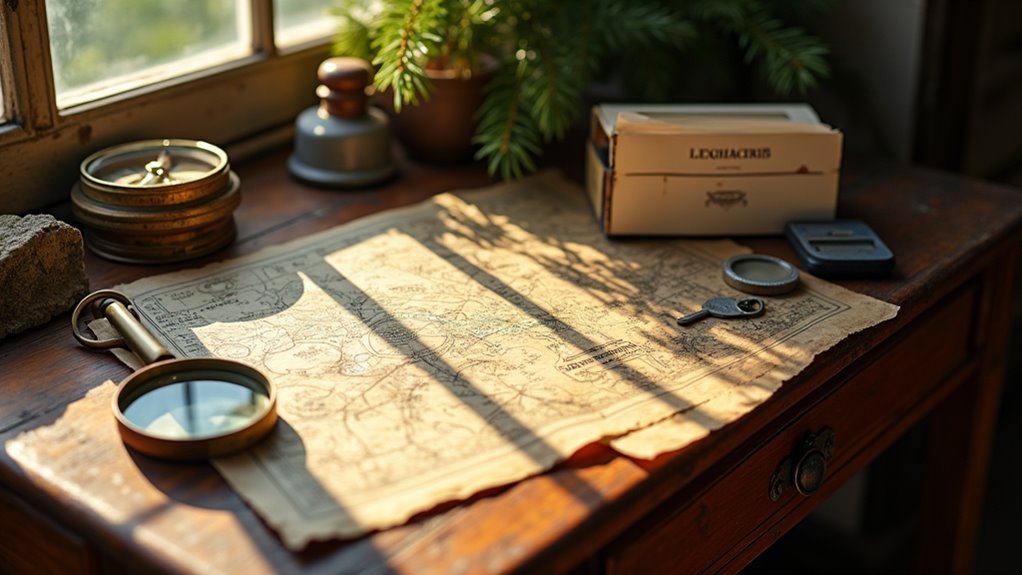Some of the links in this article may be affiliate links. If you make a purchase through these links, we may earn a small commission at no extra cost to you. Thank you.
I’ve been fascinated by geocaching ciphers ever since I found my first encrypted cache coordinates. Trust me, there’s something uniquely satisfying about cracking a ROT13 code or deciphering Morse dots and dashes while standing in the woods with just your phone. I’m not an expert by any means, but I’ve learned that understanding basic encryption methods can transform an ordinary treasure hunt into a mind-bending adventure. Ready to discover how these puzzles can elevate your next cache hunt?
The Historical Evolution of Geocaching Ciphers

Ciphers, those mysterious codes that have tantalized minds throughout history, have found a natural home in the world of geocaching.
I’m always fascinated by how ancient methods like the Caesar cipher, with its simple letter shifts, evolved into the backbone of modern geocaching puzzles.
Ancient ciphers have transformed from wartime secrets to weekend puzzles, connecting us to centuries of code-breaking tradition.
When I first started geocaching, I didn’t realize I’d need to learn Morse Code—a communication system from the 1830s!
But there’s something thrilling about decoding those dots and dashes to find hidden coordinates.
The journey from Enigma machines to today’s digital ROT13 ciphers reflects, I think, our human love of secrets.
What began with wartime encryption has become, well, a fun weekend activity for puzzle enthusiasts like us.
Understanding ROT13 and Caesar Shift Techniques
What I find fascinating about ROT13 is its self-inverse property. You know, the same algorithm that encrypts your message will decrypt it too!
It’s not exactly Fort Knox-level security, though.
I mean, any cipher that can be broken by simply counting 13 letters forward isn’t keeping any real secrets.
For beginners, I’d recommend trying ROT13 with number words—like “one” becoming “bar.” It’s perfect for practicing your decoding skills before tackling more complex geocaching puzzles.
Mastering Morse Code for Coordinate Hunting

I’ve found that mastering Morse Code’s dots and dashes is absolutely essential when you’re hunting for those tricky coordinate-based geocaches.
When I’m out on the trail, I’ll often need to quickly translate a series of beeps or flashes into actual latitude and longitude points, which can mean the difference between finding a cache or going home empty-handed.
I always keep a small Morse reference card in my geocaching kit, but honestly, once you’ve practiced enough, the patterns become second nature – just like how I can instantly recognize that ••• — ••• means I need help finding that particularly challenging cache!
Learning Morse Code Basics
The world of Morse Code might seem challenging at first, but it’s actually one of the most rewarding skills you’ll develop as a geocacher.
I’ve spent countless hours practicing those dots and dashes, and it’s opened up a whole new dimension of Geocaching Puzzles that would’ve otherwise remained unsolved.
When I started, I added a few simple tools to my Geocaching Toolbox:
- Audio apps that play Morse sequences at adjustable speeds
- Flashcards with common letters and their codes (start with A, E, S, T)
- A timing reference sheet (remember: dashes are three times longer than dots)
You’ll quickly recognize patterns like SOS (· · · — — — · · ·) and begin translating coordinate strings. Trust me, the first time you decode a hidden message that leads to a cache, you’ll feel like a secret agent!
Decoding On The Trail
When you’re finally standing at ground zero, ready to apply those Morse skills you’ve practiced, everything suddenly feels different.
That dot-dash sequence you memorized back home might blur when you’re trying to decode a puzzle in the field with mosquitoes buzzing around you!
I’ve found that regular practice with the Geocaching Toolbox really pays off in these moments.
Sometimes I’ll encounter a cache that combines Morse with another cipher—talk about a brain-bender!
But there’s nothing like that “aha” moment when dots and dashes transform into actual coordinates right before your eyes.
In my experience, the best geocachers keep a small reference card handy.
Wait, no—they’ve actually committed the basics to memory because, well, you never know when you’ll need to translate “…. . .-.. .–.” into HELP!
Portable Reference Techniques
Speaking of field tricks, portable reference techniques might just save your geocaching adventure when you’re staring blankly at a series of dots and dashes.
I’ve found that mastering Morse Code for coordinate hunting is essential for tackling those tricky puzzle cache ciphers and codes mystery elements without lugging reference books around.
Here are my go-to portable methods:
- Create a custom pocket-sized cheat sheet with common geocaching symbols like A (·—) and numbers (dash-dash-dash for 0)
- Practice using smartphone apps that let you quickly translate on the go—super helpful when you’re deep in the woods
- Record audio versions of the code alphabet to listen while hiking, training your ear for faster decoding
With just 26 letters to memorize, you’ll be deciphering coordinates in no time.
Trust me, it’s worth the effort!
Polyalphabetic Substitution: Vigenère and Gronsfeld Ciphers

Polyalphabetic substitution ciphers represent a significant leap forward in encryption technology, with Vigenère and Gronsfeld standing as fascinating examples I’ve encountered in geocaching puzzles.
Unlike simple substitution methods, these ciphers use keywords to create variable shifts for each letter, making them much tougher to crack.
When I’m tackling puzzle caches, I often see Vigenère ciphers transforming text like “GOOD DOG” into “PLSX TWF” through a repeating keyword pattern. The Gronsfeld variation uses numbers instead of letters for the key, but the concept remains similar.
What makes these methods special for geocaching is their perfect balance of challenge and solvability. I’ve found the Geocaching Toolbox particularly helpful—it offers decoders for both types, saving me from manual calculations when I’m out in the field.
Visual Encryption Methods: Pigpen and Templar Codes
I’ve always found the Pigpen and Templar Codes fascinating for their clever visual approach to encryption – those little grids and symbols can transform ordinary text into something that looks like ancient runes!
If you’re stuck on a geocaching puzzle using these methods, try identifying just one or two letters first, since once you crack the pattern, the rest falls into place like dominos.
You’ll often spot these historic ciphers in field puzzles where traditional alpha-numeric codes wouldn’t survive the elements, making them perfect for those weathered clues hidden under rocks or carved into wooden posts.
Symbol-Based Visual Codes
Why are symbol-based visual codes so popular in geocaching?
I think it’s because they’re visually intriguing yet surprisingly accessible.
When I’m designing a cache page, I often turn to the Pigpen Cipher—that classic tic-tac-toe grid system where each letter becomes a unique geometric symbol.
You’d be amazed how many geocachers light up when they spot these symbols on a cache!
- The Pigpen Cipher is beginner-friendly—crack one symbol and you’ve got the key to the whole message
- Templar Code variations add mystique with their Maltese cross design, perfect for history-themed caches
- These ciphers don’t require special tools—just a pencil and paper to decode
Well, in my experience, visual codes create that “aha!” moment that makes finding a cache feel like a real discovery.
Historic Geocaching Applications
Throughout history, visual encryption methods have found a natural home in the world of geocaching.
I’ve found the Pigpen Cipher to be widely used, with its distinctive tic-tac-toe grid symbols replacing letters in cache descriptions.
What’s fascinating is that once you identify one symbol, like the one for “T,” you can usually crack the entire message.
When browsing Use of geocaching.com services, you’ll notice the Templar Code variation too, which uses a Maltese cross as its base.
I think it’s pretty cool how these methods connect modern cachers to historical secret societies like the Freemasons.
Sometimes the grids appear without dots, but the principle’s the same—consistent symbol-letter mappings that, well, make these visual puzzles challenging yet accessible for all skill levels.
Decoding Challenge Tips
When you’re facing a Pigpen or Templar code in your next geocache, don’t panic!
I’ve cracked dozens of these visual ciphers, and they’re actually pretty fun once you get the hang of them.
Before you rush to view geocache location details, try these decoding methods:
- Look for frequent symbols first—these often represent common letters like E, T, or A
- Start with simple words like “the” to confirm your grid mapping is correct
- Use the Geocaching Toolbox online if you’re stuck—it’s a lifesaver!
The Templar Code uses a Maltese cross as its base, which makes it easier to identify once you’ve seen it before.
I think what makes these ciphers satisfying is that moment when everything clicks and, suddenly, you can read the whole message!
Essential Tools and Resources for Puzzle Solvers
Success in geocaching puzzles often hinges on having the right tools at your disposal.
I’ve found that Geocaching Toolbox is absolutely indispensable—it links to 20 different decryption sites and offers tools for ROT13 and Vigenère ciphers.
You’ll want to bookmark this in your geocaching.com lists for quick access.
For practice with substitution ciphers, I’d recommend Rumkin.com.
It’s, well, probably the most thorough resource I’ve used for Caesar and Baconian ciphers.
Don’t overlook Graham Haddock’s articles in Seeker Issues 36-38.
They’re fantastic educational resources that I think every puzzle solver should read.
What I love about Geocaching Toolbox is that it’s available in multiple languages—English, Dutch, German, Slovak, and Spanish—making puzzle solving accessible to geocachers worldwide.
Advanced Cipher Strategies for Multi-Stage Caches
Multi-stage caches present a whole different level of challenge when it comes to cipher strategies.
I’ve found that layering is often the key – you might need to crack a ROT13 cipher first, which then reveals a keyword for a Vigenère cipher later.
Layering ciphers creates the perfect puzzle trail—decode one level to unlock the key for the next challenge.
It’s like peeling an onion where each layer gets trickier!
When tackling these multi-stage puzzles, I rely on:
- Looking for hidden keywords in plain sight from earlier stages
- Using tools like Geocaching Toolbox that links to 20+ decryption sites
- Watching for transposition tricks after substitutions (that “GOOD DOG” becoming “DGOGDOO” gets me every time!)
Historical encryption methods, like those inspired by Enigma machines, often influence these cache designs.
Trust me, nothing beats the satisfaction of cracking that final coordinate!
Creative Applications of Encryption in Cache Design
How are geocachers transforming ordinary puzzles into mind-bending encryption adventures? I’ve discovered some ingenious methods while using geocaching.com services is subject to exploring this hobby. Cachers hide messages in plain sight using techniques that’ll make you feel like a real cryptographer!
| Cipher Type | Application | Difficulty |
|---|---|---|
| ROT13 | Coordinate shifting | ★★☆☆☆ |
| Baconian | Font variations | ★★★☆☆ |
| Pigpen | Symbol substitution | ★★★★☆ |
| Birds on Wire | Visual patterns | ★★★☆☆ |
| Magic Eye | 3D stereograms | ★★★★★ |
I think the most creative caches incorporate multiple methods—maybe a ROT13 clue leading to a Pigpen message, then finally revealing coordinates in a Magic Eye puzzle. These layered approaches, subject to the terms of fair play, create truly unforgettable finds!
Frequently Asked Questions
How Do I Decode a Cipher Without Knowing Which Method Was Used?
I’m drowning in a sea of encrypted gibberish! Start with Cipher Identification by looking for patterns. I’d use Frequency Analysis to count letter occurrences—common letters like ‘E’ reveal themselves even in disguise. Try popular methods sequentially until something clicks.
Are There Smartphone Apps Specifically Designed for Geocaching Cipher Solving?
I’ve found several geocaching cipher apps worth downloading. My top App Recommendations include “Geocaching Toolbox” and “Cipher Tools.” Feature Comparisons show they handle ROT13, Morse, and various encryption methods.
Can Weather Conditions Affect the Integrity of Physical Cipher Clues?
Yes, I’ve seen Weather Effects severely impact Clue Integrity. Rain can smudge ink, sun fades paper, and extreme temperatures may warp materials containing your cipher clues. I always recommend waterproof containers.
How Do I Create My Own Custom Cipher for Hiding Geocaches?
I’d start with Cipher Design basics—mix known codes with personal twists. Choose meaningful Key Selection that’s challenging but solvable. I’ve found substituting symbols for letters creates satisfying puzzles for fellow geocachers.
What’s the Difficulty Rating System for Cipher-Based Geocaching Puzzles?
Geocaching puzzles use a 1-5 star system where cipher complexity impacts the Rating Criteria. I’ve seen Difficulty Evolution as puzzles move from simple substitution ciphers to multi-layered encryption requiring specialized knowledge.